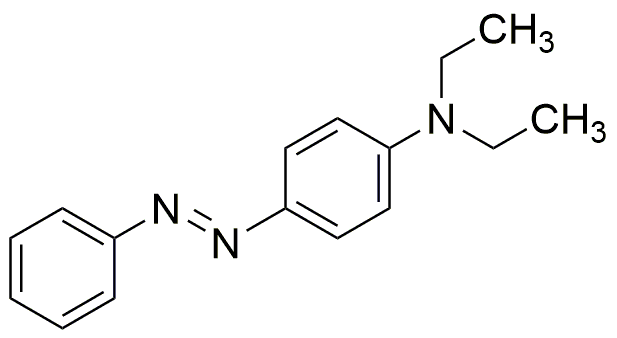4-(Diethylamino)azobenzene is widely utilized in research focused on:
- Dyes and Pigments: This compound is a key ingredient in the production of vibrant dyes used in textiles and inks, providing excellent color stability and brightness.
- Photochemical Applications: It serves as a photosensitive material in photolithography, crucial for the manufacturing of electronic components and microchips.
- Biological Research: The compound is employed in studies involving cellular imaging and tracking, helping researchers visualize and understand cellular processes.
- Analytical Chemistry: It is used as a reagent in various analytical techniques, aiding in the detection and quantification of other substances in complex mixtures.
- Polymer Chemistry: This chemical is applied in the development of photoresponsive polymers, which can change properties when exposed to light, useful in smart materials and coatings.
General Information
Properties
Safety and Regulations
Applications
4-(Diethylamino)azobenzene is widely utilized in research focused on:
- Dyes and Pigments: This compound is a key ingredient in the production of vibrant dyes used in textiles and inks, providing excellent color stability and brightness.
- Photochemical Applications: It serves as a photosensitive material in photolithography, crucial for the manufacturing of electronic components and microchips.
- Biological Research: The compound is employed in studies involving cellular imaging and tracking, helping researchers visualize and understand cellular processes.
- Analytical Chemistry: It is used as a reagent in various analytical techniques, aiding in the detection and quantification of other substances in complex mixtures.
- Polymer Chemistry: This chemical is applied in the development of photoresponsive polymers, which can change properties when exposed to light, useful in smart materials and coatings.
Documents
Safety Data Sheets (SDS)
The SDS provides comprehensive safety information on handling, storage, and disposal of the product.
Product Specification (PS)
The PS provides a comprehensive breakdown of the product’s properties, including chemical composition, physical state, purity, and storage requirements. It also details acceptable quality ranges and the product's intended applications.
Certificates of Analysis (COA)
Search for Certificates of Analysis (COA) by entering the products Lot Number. Lot and Batch Numbers can be found on a product’s label following the words ‘Lot’ or ‘Batch’.
Número de catálogo
Número de lote/lote
Certificates Of Origin (COO)
This COO confirms the country where the product was manufactured, and also details the materials and components used in it and whether it is derived from natural, synthetic, or other specific sources. This certificate may be required for customs, trade, and regulatory compliance.
Número de catálogo
Número de lote/lote
Safety Data Sheets (SDS)
The SDS provides comprehensive safety information on handling, storage, and disposal of the product.
DownloadProduct Specification (PS)
The PS provides a comprehensive breakdown of the product’s properties, including chemical composition, physical state, purity, and storage requirements. It also details acceptable quality ranges and the product's intended applications.
DownloadCertificates of Analysis (COA)
Search for Certificates of Analysis (COA) by entering the products Lot Number. Lot and Batch Numbers can be found on a product’s label following the words ‘Lot’ or ‘Batch’.
Número de catálogo
Número de lote/lote
Certificates Of Origin (COO)
This COO confirms the country where the product was manufactured, and also details the materials and components used in it and whether it is derived from natural, synthetic, or other specific sources. This certificate may be required for customs, trade, and regulatory compliance.


